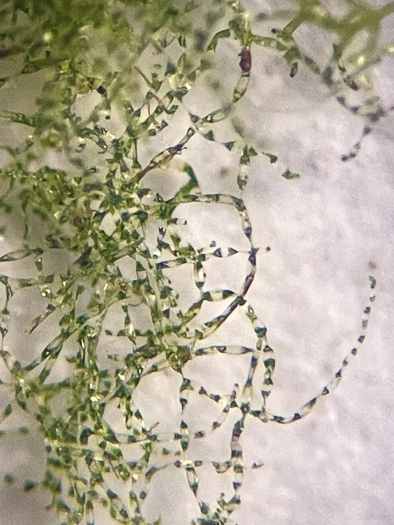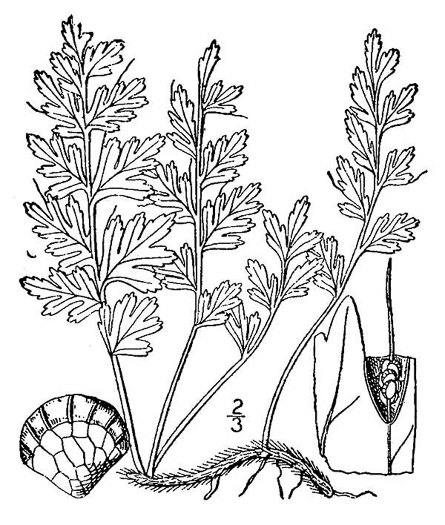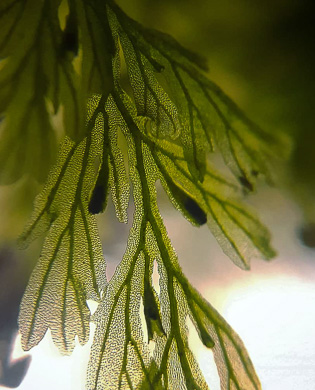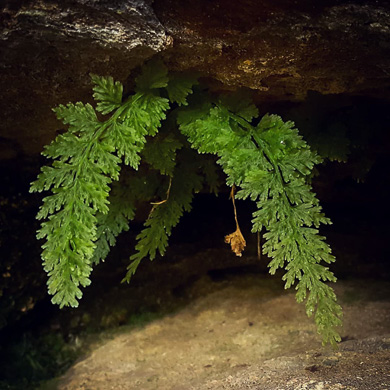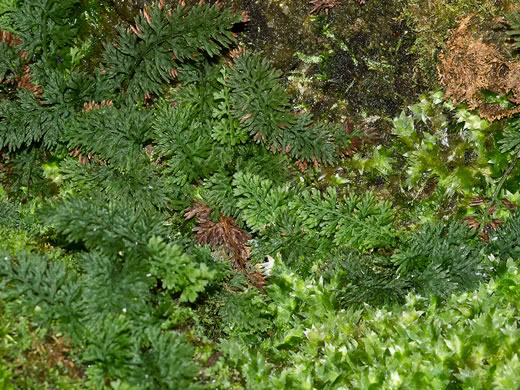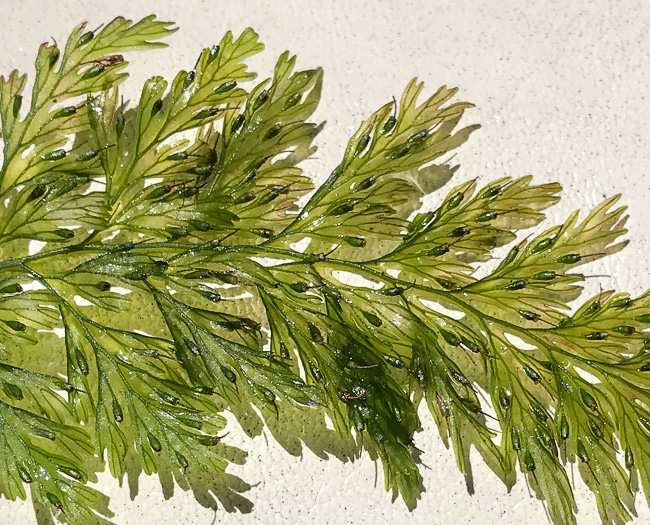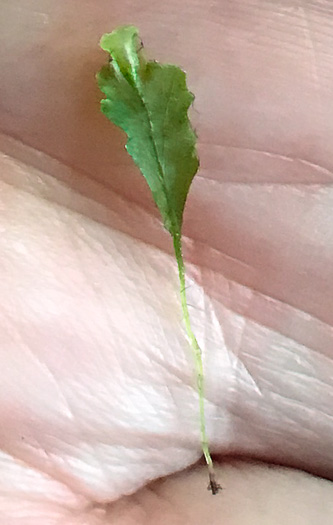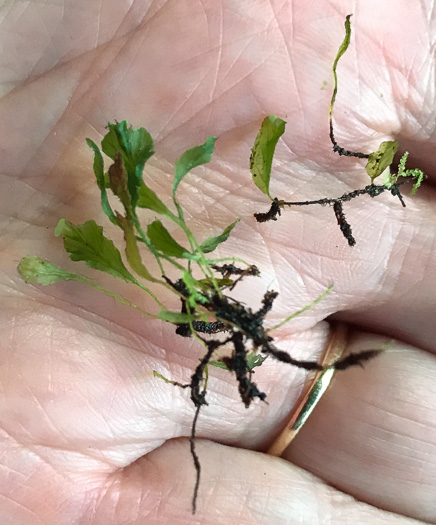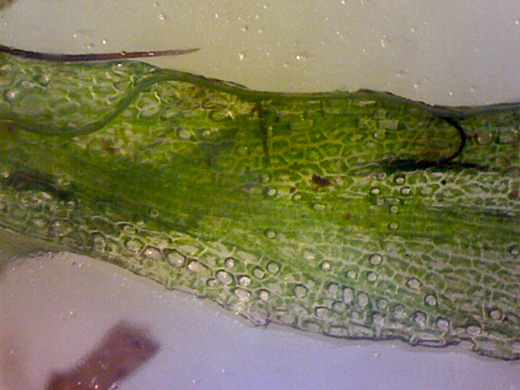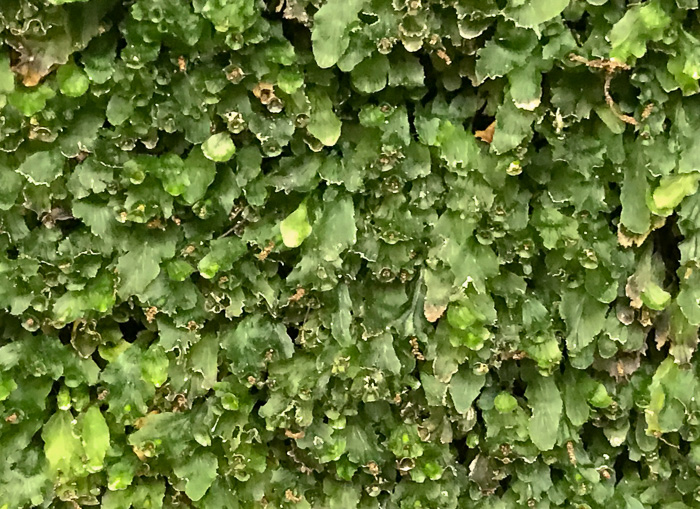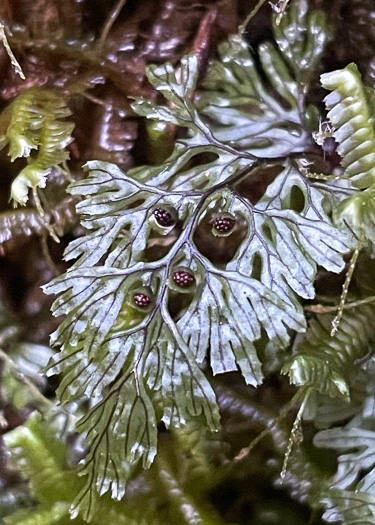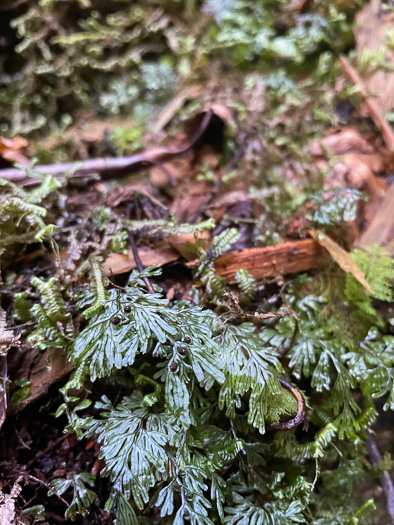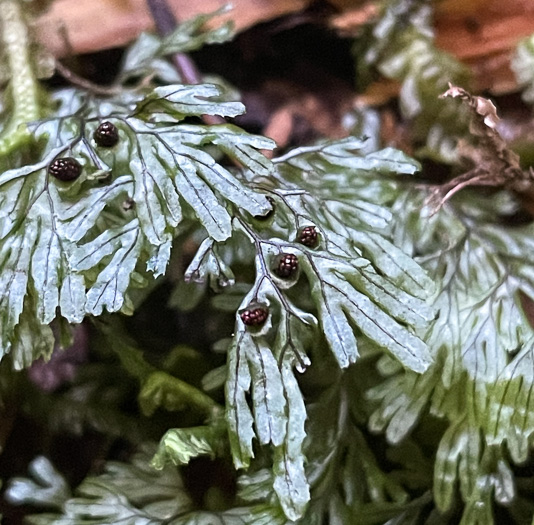Hovering over an image will enlarge it and point out features (works better on desktop than on mobile).
![]() A camera indicates there are pictures.
A camera indicates there are pictures.
![]() A speaker indicates that a botanical name is pronounced.
A speaker indicates that a botanical name is pronounced.
![]() A plus sign after a Latin name indicates that the species is further divided into varieties or subspecies.
A plus sign after a Latin name indicates that the species is further divided into varieties or subspecies.
Most habitat and range descriptions were obtained from Weakley's Flora.
Your search found 5 taxa in the family Hymenophyllaceae, Filmy Fern family, as understood by Weakley's Flora.

![]() Common Name:
Grotto-felt, Appalachian Trichomanes, Weft Fern
Common Name:
Grotto-felt, Appalachian Trichomanes, Weft Fern
Weakley's Flora: (4/24/22) Crepidomanes intricatum FAMILY: Hymenophyllaceae
SYNONYMOUS WITH PLANTS National Database: Trichomanes intricatum FAMILY: Hymenophyllaceae
SYNONYMOUS WITH Vascular Flora of the Carolinas (Radford, Ahles, & Bell, 1968): Trichomanes - "a filamentous gametophyte" 009-01-? FAMILY: Hymenophyllaceae
Habitat: On ceilings or back walls of grottoes, especially in humid gorges or near or behind waterfalls
Rare
Native to the Carolinas & Georgia

![]()
![]() Common Name:
Appalachian Filmy-fern, Appalachian Bristle Fern
Common Name:
Appalachian Filmy-fern, Appalachian Bristle Fern
Weakley's Flora: (4/24/22) Vandenboschia boschiana FAMILY: Hymenophyllaceae
SYNONYMOUS WITH PLANTS National Database: Trichomanes boschianum FAMILY: Hymenophyllaceae
SYNONYMOUS WITH Vascular Flora of the Carolinas (Radford, Ahles, & Bell, 1968): Trichomanes boschianum 009-01-001 FAMILY: Hymenophyllaceae
Habitat: On rock outcrops, usually vertical or overhanging, usually in deeply shaded grottoes receiving seepage or spray from waterfalls
Rare
Native to the Carolinas & Georgia

![]()
![]() Common Name:
Dwarf Filmy-fern, Bristle Fern, Peters' Filmy Fern
Common Name:
Dwarf Filmy-fern, Bristle Fern, Peters' Filmy Fern
Weakley's Flora: (4/24/22) Didymoglossum petersii FAMILY: Hymenophyllaceae
SYNONYMOUS WITH PLANTS National Database: Trichomanes petersii FAMILY: Hymenophyllaceae
SYNONYMOUS WITH Vascular Flora of the Carolinas (Radford, Ahles, & Bell, 1968): Trichomanes petersii 009-01-002 FAMILY: Hymenophyllaceae
Habitat: On vertical faces of acidic rock outcrops in humid gorges (in sw. NC, nw. SC, and ne. GA, primarily of the Savannah River drainage), in the context of the very humid escarpment gorges on relatively dry rocks, not on rocks receiving substantial seepage or spray from waterfalls, also on outcrops of Altamaha Grit in the Coastal Plain, on tree bark (especially Magnolia grandiflora and Fagus grandifolia) in swamps and hammocks (in FL, LA, and MS), and on chert around limestone sinkholes (in FL)
Rare
Native to the Carolinas & Georgia

Common Name: Gorge Filmy-fern, Taylor's Filmy-fern
Weakley's Flora: (4/14/23) Hymenophyllum tayloriae FAMILY: Hymenophyllaceae
SYNONYMOUS WITH PLANTS National Database: Hymenophyllum tayloriae FAMILY: Hymenophyllaceae
SYNONYMOUS WITH Vascular Flora of the Carolinas (Radford, Ahles, & Bell, 1968): Hymenophyllum - "a branching ribbon-like gametophyte with marginal rhizoids and small, ovate, plate-like gemmae several cells wide" 009-02-? FAMILY: Hymenophyllaceae
Habitat: Spray cliffs near waterfalls, permanently moist ceilings of grottoes in escarpment gorges with high rainfall
Rare
Native to the Carolinas & Georgia

![]() Common Name:
American Tunbridge Filmy-fern, Tunbridge Fern
Common Name:
American Tunbridge Filmy-fern, Tunbridge Fern
Weakley's Flora: (2/10/25) Hymenophyllum cordobense FAMILY: Hymenophyllaceae
SYNONYMOUS WITH PLANTS National Database: Hymenophyllum tunbrigense FAMILY: Hymenophyllaceae
SYNONYMOUS WITH (ORTHOGRAPHIC VARIANT) Vascular Flora of the Carolinas (Radford, Ahles, & Bell, 1968): Hymenophyllum tunbridgense 009-02-001 FAMILY: Hymenophyllaceae
Habitat: Moist rock faces in an escarpment gorge with high rainfall
Rare (known in North America from only one county)
Native to South Carolina
Your search found 5 taxa. You are on page PAGE 1 out of 1 pages.


